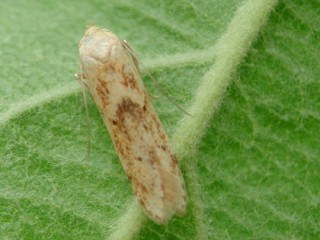
There is one generation per annum in the UK with a very small partial second flight of adults in the autumn and early winter.
- Adults of the first main generation fly in June and July, about the same time as codling moth.
- Eggs are laid (on average 70 per female at a rate of 20 per day) on foliage or amongst debris on the tree. Eggs kept at constant temperatures of 8, 18 or 25oC hatch after 44, 7 and 4 days respectively.
- Larvae occur from July to October. Initially, they feed on debris such as in the rolled edge of a dead leaf, in a dead flower or burrowed into shrivelled fruitlets.

- Older larvae construct a shelter of dead leaves and flowers webbed together.
- Damage to fruits occurs from late July onwards consisting initially of small single holes. As the larvae grow the damage becomes more extensive.
- When fully fed in the autumn or early winter, larvae leave their feeding sites and move to the soil or amongst debris on the ground where they form a silken cocoon in which they pupate.
- A small proportion of very early maturing larvae pupate and emerge the same year, giving rise to a small second flight in the autumn or early winter. If eggs are laid, they are unlikely to develop successfully.
